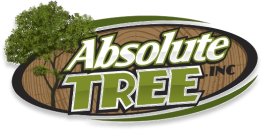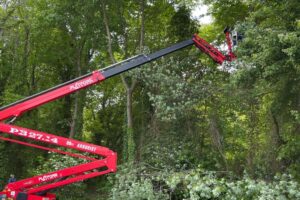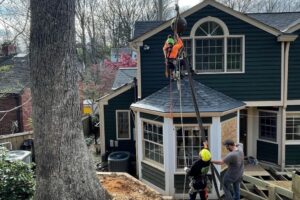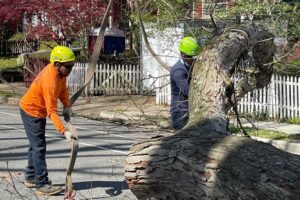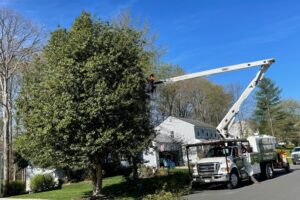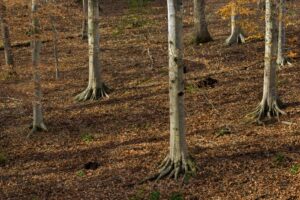When it comes to dealing with insect and disease issues, it’s important to get an early start if you want to have a beautiful and healthy landscape all season. It’s always better to prevent insects and diseases rather than deal with pest infestations and diseases after your tree has already been attacked. Besides being easier, prevention will save you money that would otherwise be spent on pesticides, and you’ll get to enjoy a more attractive landscape all year.
However, preventing bugs and diseases from attacking your trees and shrubs isn’t always simple or easy. It involves several steps, such as proper plant care, monitoring, and treatment. We recommend following a protocol called IPM (Integrated Pest Management). This ecological approach will provide effective results with the minimum use of harmful chemicals. To get informed on the most common diseases and how to prevent insect and disease problems on trees, read the following article.
Common Tree Diseases in Northern Virginia
- Apple Scab – This leads to crabapple and apple trees shedding their leaves prematurely during late spring and early summer. The best way to recognize apple scab is the black and brown spots on leaves.
- Anthracnose – Anthracnose is often misdiagnosed as oak wilt. It causes the leaves to develop brown, dry, and blotchy spots. It usually attacks trees early in the season.
- Leaf Spot Disease – Leaf spot disease creates spots on tree leaves and can be brown, black, or tan, creating dark spot pigment on the leaves.
- Cytospora Canker – This disease is widely known for causing discoloration on areas of tree branches and trunks. It’s most common among mature trees (15 years or older). It turns the tree’s needles brown and kills its lower branches.
- Black Knot – Black knot creates an olive-green, soft lump on twigs, eventually changing to hard black knots when the fall arrives. If you leave the black knot untreated, it can kill off the whole tree.
IPM – Basic Principles
Integrated Pest Management consists of specific methods developed for fighting and preventing insect and disease problems on trees. These methods are consistent in monitoring pests for proper plant care practices, immediate action, correct treatment approaches, and planting pest-resistant plant varieties.
The main goal of IPM is to develop long-term early prevention of insects and pests and help you with tree preservation. It works on a logical principle, meaning that eliminating or reducing the pest population at the very beginning will significantly reduce the risk of any damage to the trees.
Although it might sound complicated, IPM is a simple process that helps with tree disease & insect control. It consists of a few essential steps, which we’ll thoroughly explain below.
Monitoring
Regular monitoring means that you need to check your plants daily which will allow you to detect any early signs of pest infestation while the population is still low and therefore easy to eliminate.
At this stage, it’s easy to interrupt their growth while you still have control. For example, the presence of mountain pine beetle is easiest (and advised) to monitor in the winter. How do you know they’re taking shelter? If you notice the pitch tubes, remember to cut off a piece of bark and check if there is discoloration of the area (wood) under the bark (grayish-blue). If there is such discoloration, we highly recommend calling the arborist to take the tree down.
Why is regular monitoring of pine trees important? Well, regular monitoring of these trees in the winter and removing the infected trees will prevent the beetles from infesting the neighboring trees. That’s why we accentuate consistent monitoring and immediate action as it will make a huge difference in terms of keeping your trees healthy.
Proper Plant Care
Proper plant care practices are another crucial step for stopping the growth of a vast number of pests. It is very simple since it involves maintaining cleanliness and keeping your beds and plants well-tended. We recommend rotating your annual crops to different areas of the garden every year, which will minimize any pest problems.
Also, cleaning up old leaf litter on the base of the plants is an effective way of eliminating possibly problematic insects. Another way to lower the risk of plant damage is by observing the right time to plant trees. In the warmer months, keep your plants hydrated throughout the whole year, as dehydrated plants are prone to damage. Furthermore, in some cases, it is recommended to change the soil before planting by applying organic matter on a frequent basis. To prevent the growth of weeds and to retain moisture, use a dense layer of organic mulch. When it comes to newly-planted trees, take extra care.
Good Planting Practices
Planting properly is another crucial factor in preventing insect and disease problems on trees. There are a couple of tips to follow, including:
- Planting pest-resistant Varieties – If you want to plant some popular plant that is prone to pests, we`re happy to inform you that there is a resistant variety that has been bred for it. Choose varieties that are more vigorous and robust which will greatly influence pest resistance.
- Plant at the right time and the right place -Every plant has a specific preference when it comes to soil, sunlight, temperature, moisture, sunlight, space, etc. If you plant at the wrong time and wrong place, it will only stress out the plant while allowing numerous pests and insects to dive in.
- Plant diversity – When some of the aforementioned pests like Mountain Pine Beetle become prevalent, they can kill areas of trees. We recommend planting different kinds of trees, kinds, to ensure that you have some plants left if infestation happens. Besides, diversity is great for improving the overall health and look of your landscape.
Treat Insects & Diseases Only When Needed
Treat the trees only when needed after making sure there are biological controls in place. Garden-friendly insects, such as mantids, ladybugs, parasitic wasps, and lacewings, can eat up a large number of pests. However, if the situation gets out of control, consider calling professionals for help to help you with pesticides.
Call Absolute Tree for Accurate Diagnosis & Treatment
The final step to prevent disease problems on trees is to have your trees diagnosed by professional local tree service company, especially if you have no prior experience on the subject. Hire only a trusted service to help you with tree maintenance and fertilization since not all pest control companies are certified.
For the Absolute Best Tree Service in Northern Virginia, call Absolute Tree Today!
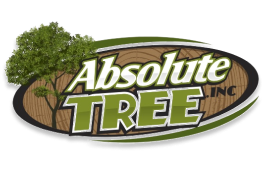
Author Profile: Ashley Davis
Over the last 19 years, Absolute Tree has grown a reputation as one of the premier tree service companies in the Northern Virginia areas. And there’s a good reason for this—we love trees and our passion for them shows. When you call on Absolute Tree for tree service, you aren’t just getting “some guys who cut down trees.” You’re hiring highly skilled arborists who understand the growth of trees and consider tree care an art form.
Stay Up-to-date!
Swing in each month for new articles, pest alerts, local resources, tree care tips, tree health updates, and landscape maintenance ideas
